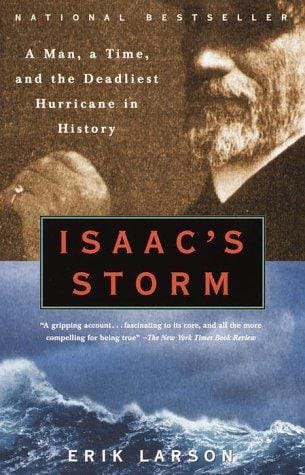Isaac's Storm: A Man, a Time, and the Deadliest Hurricane in History
Discover the drama, tragedy, and lessons of Erik Larson’s “Isaac’s Storm,” the gripping non-fiction account of the 1900 Galveston hurricane.

Introduction
When Erik Larson published “Isaac’s Storm: A Man, a Time, and the Deadliest Hurricane in History” in 1999, he transformed a little-known natural disaster into a spellbinding narrative that reads like a thriller. Centered on the devastating Galveston hurricane of 1900 and the U.S. Weather Bureau meteorologist Isaac Monroe Cline, the book plunges readers into a pivotal moment when burgeoning scientific optimism collided with the raw, unpredictable power of nature. This article explores why the work remains essential reading for history buffs, weather enthusiasts, and anyone who loves riveting nonfiction.
The Book at a Glance
Larson’s 336-page chronicle weaves personal accounts, archival documents, and meteorological data into an epic tale of hubris, tragedy, and survival. The narrative alternates between atmospheric descriptions of Galveston’s prosperous boomtown energy and ominous signs swirling in the Gulf of Mexico. By placing Isaac Cline at the heart of the story, Larson offers a dual perspective: the confident forecaster convinced that no hurricane could seriously harm Galveston, and the stunned eyewitness who watched a city—and parts of his own life—washed away in a matter of hours.
Author Erik Larson’s Storytelling Power
Larson is celebrated for taking complex historical events and presenting them through the lens of compelling human drama. In “Isaac’s Storm,” he leans on meticulous research while embracing novelistic techniques: cliffhanger chapters, vivid sensory details, and tightly drawn character arcs. The result keeps pages turning even for readers who know the ending. His decision to spotlight telegram transcripts, barometric readings, and Weather Bureau memos not only grounds the narrative in fact but also underscores how institutional confidence—sometimes arrogance—shapes real-world consequences.
Galveston 1900: The Setting of Doom
Before the storm, Galveston was dubbed the “Wall Street of the Southwest,” flaunting Victorian mansions, streetcars, and vibrant cotton markets. Its residents believed the city’s shallow sandbar location and warm Gulf climate made it a seaside paradise immune to serious storms. The lack of a seawall, combined with low elevation, left the island dangerously exposed, yet boosters and journalists maintained a near-mythic faith in progress. Larson’s richly detailed backdrop captures a society perched on the brink of disaster, reminding us how prosperity can mask vulnerability until it is far too late.
Science vs. Nature
The book examines turn-of-the-century meteorology, a field wrestling with limited data and political interference. U.S. Weather Bureau officials dismissed Cuban forecasters’ warnings, partly to preserve national prestige. Isaac Cline himself publicly assured citizens that a hurricane “need not be seriously considered.” When wind and rain intensified on September 8, 1900, residents misread the signs until escape routes vanished under rising water. Larson’s critique is subtle but pointed: technological optimism must always make room for humility before nature’s might.
Isaac Cline: The Man Behind the Storm
Cline emerges as a brilliant yet conflicted protagonist. Raised in rural Tennessee, he rose quickly within the Weather Bureau through diligence and intellectual curiosity. At first, he embodies the era’s belief in reason conquering chaos. Yet personal tragedy—most notably the loss of his wife in the floodwaters—shatters that certainty. Larson does not condemn Cline outright; instead, he portrays him as a cautionary figure whose strengths and flaws mirror the broader American psyche on the cusp of the 20th century.
Tragedy and Transformation
After Galveston, Cline devoted himself to improving hurricane detection and advocacy for stronger coastal defenses. His evolution from skeptic to reformer offers a redemption arc that deepens the narrative’s emotional resonance. Readers witness how disaster can catalyze both individual growth and systemic change. The rebuilding of Galveston—complete with an eventual seawall and citywide elevation project—illustrates how societies learn, adapt, and, occasionally, atone for earlier oversight.
Key Themes and Takeaways
Several powerful motifs run through “Isaac’s Storm.” Hubris, the dangerous overconfidence in technology and expertise, looms largest. The story also explores communication breakdowns: how bureaucratic gatekeeping and nationalist pride prevented life-saving warnings from reaching the public. Finally, Larson highlights human resilience, chronicling countless acts of bravery amid chaos. For modern readers facing increasingly frequent extreme weather events, these themes feel strikingly contemporary, encouraging a sober reassessment of our own disaster preparedness.
Why ‘Isaac’s Storm’ Still Matters Today
Climate change has heightened the intensity and unpredictability of hurricanes worldwide. Larson’s work, though set more than a century ago, offers timeless lessons about respecting scientific evidence, supporting transparent communication, and investing in infrastructure before catastrophe strikes. Emergency planners, educators, and policymakers frequently cite the Galveston hurricane as a historic case study; “Isaac’s Storm” brings that lesson plan to life, making it accessible and unforgettable for general audiences.
Final Thoughts
“Isaac’s Storm: A Man, a Time, and the Deadliest Hurricane in History” stands at the intersection of narrative nonfiction and cautionary tale. Erik Larson’s evocative storytelling ensures that readers not only grasp the scale of the 1900 Galveston disaster but also feel its emotional weight. Whether you pick up the book for its suspense, its rich historical context, or its scientific insights, the experience lingers long after the final page. In an era when extreme weather dominates headlines, revisiting Isaac Cline’s story is both riveting and urgently relevant.



